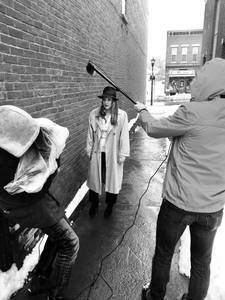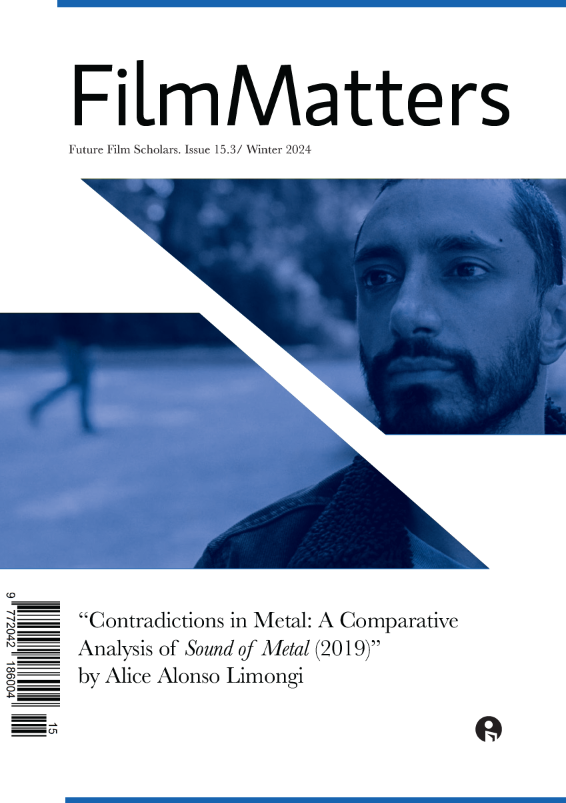Murder Go Round (The Student Film That Never Was) is a feature-length student film produced by the liberal arts institution, St. Lawrence University (SLU), and directed by their 2018 film graduate, Austen Sprake. Like many, Sprake sparked his adoration for filmmaking during high school and since has budded into a writer, producer, director, actor, editor, and cinematographer. Granted the majority of student feature-length films are created in auspicious circumstances with accessible film tools at their disposal, Murder Go Round (The Student Film That Never Was) is unique for the reason Sprake was the first film major in the history of SLU. In the face of adversity, Sprake constructs a fruitful feature-length film, but during post-production he forsakes his initial narrative and conceives an invaluable visual medium for student filmmakers. Austen Sprake participated in this interview with Film Matters via email in summer 2018.
Lily Frame: Tell me about Murder Go Round.
Murder Go Round was my senior year project at St. Lawrence. After years of working on different short films, music videos and documentaries at school, I wanted to step up and work on a large scale (for our school at least) feature film, consisting of an all Saint Lawrence University cast and crew. The film would be a feature length version of my award winning short film Murder Go Round, and I would continue experimenting with the murder mystery genre in it.
What influenced the expanding of the initial short film, Murder Go Round, into a feature film? What can viewers expect the differences to be between the two?
With all the different films I made throughout my time at SLU, I had the most fun with and achieved the most success with the short film version of Murder Go Round. Making a film where we never revealed who the killer was made it a lot of fun, because as the director, my job was to present all the subtle clues on screen using narration, and what is shown or not shown visually. I wanted to continue these films but into a much longer version, which would be a lot of fun but also very challenging at the same time. The difference between the two is the increase in characters/suspects, and the theme of the characters. In the short film, we had five characters based around pretty basic archetypes (The Blonde, The Drug Dealer, The Tool), but with the feature length the amount of characters has increased to nine, and we approached the characters with the theme of cinema. Each character comes from a place in cinema, such as the alien, the wild west gunslinger, or the 1950’s noir detective. In doing so, we had a lot more to experiment and expand on with the film.
For your Murder Go Round short, you had a $40 budget; and for your feature-length version, your budget increased to $10,000, thanks to a crowdfunding campaign. Did you meet your requirements from crowdfunding backers?
We were able to raise over 600 dollars from Indiegogo, which we used to fund some of our amazing props, and buy the very expensive alien mask. But the extra $6,000 came from our school’s government. I went to two meetings, and pitched and argued my way into getting the money, on the condition I would buy a Black Magic 4k camera for not only the shoot, but on the condition after the shoot I would donate to the school for future students. Just by negotiating and by explaining the good the film would do for the student community, I was able to fund the film I wanted to make, and get equipment for the school too.
Did you complete your intended shooting schedule for Murder Go Round? What are your tips for staying on track?
After a year of a lot of ups and downs, I wasn’t able to finish the original goal of the film. I’m still releasing a great film, Murder Go Round: The Student Film that Never Was, a documentary about the making of the film, and all the do’s and don’ts’s of student filmmaking, and that will be coming out soon on Amazon Prime. My tips are all about the story. While I love what we made, I could have been less ambitious in my large goals for the project, and that all goes down to the script. Make a film you know you can make. Size and scale don’t matter, if you have a good story you can make with as little set locations and actors as possible, you will be set. Many amazing films, large and small budget films, are made with very little amount of sets, and sometimes only an actor or two. Make the film you know you can make, and be proud of.
How have video games influenced your feature-length rendition of Murder Go Round?
I guess this film can take some inspirations from video games in the way the information is presented to the audience, specifically in puzzle games. I designed this movie so that the audience would almost be a detective in a video game, looking around the frame for whatever visual clues they can find.
Audience interaction is a fundamental aspect of both versions of Murder Go Round. How does the feature-length format help you to especially exploit this interaction?
With almost all the characters, my goal was to create a new way of telling the murder mystery, which also related to the character. In each character’s story of the night when he/she died, I applied a new trick that made the story more interesting, but also presented the evidence in a different way. The gunslinger told her story through a series of still photos, the Zombie through one long tracking shot, The Patriot’s story was told through surveillance footage are examples.
How does Murder Go Round avoid stereotypical genre characterization?
While each character is a film genre characterization, we made them unique in our own design of the characters. The wild west gunslinger character is combined with the theme of steampunk with her metal arm, our zombie is shown as a good and complete character rather than a monster, and our Princess sometimes turns from the sweet, innocent, typical princess to an evil version of herself.
In The Hill News, you said you designed the Murder Go Round feature like a “Coen-Brother-style film.” Can you say more about this?
Wacky characters and wacky camera angles.
What challenge(s) did you stumble upon whilst filming Murder Go Round?
Towards the end of the year, we weren’t able to finish the original goal of the film for multiple problems. We had multiple outdoor shoots that needed to happen in April, all of those were cancelled due to a last minute snow storm that lasted a week. We had some technical problems with the camera, which stopped us from filming for another week, and we had issues with our budget but also towards the end of the year, it became close to impossible to schedule all our student actors and crew into a room for a couple hour shoot. Going back now, I wish I had a much smaller cast, and a less ambitious script and story, but I was super proud of what we did shoot, and of the result being the documentary of the whole process.
In your first feature-length production, for Murder Go Round, you only employed students who attend St. Lawrence University (SLU). What departments at SLU were represented in your cast and crew?
Mostly we had people from the PCA department (Performance and communications arts), and if the school had a film major, I’m sure we would have some from there. But we had actors and crew members from almost every department.
In my research, I learned you were the first film major at SLU. What was the process for creating this major? What is the film community like today at SLU?

Murder Go Round’s (The Feature Film That Never Was) consisted of an exclusive cast and crew of students from St. Lawrence University
The school allowed me to create my own major, a “multi field major”, in that I could combine two majors to create my own. After many proposals, I was able to become a Film/Performance major at my school, but besides some acting classes my first two years at school, I mostly took all Film classes. I would like to think Film is in a much better spot now at SLU, being a bit apart for things I did, and with many other students and teachers getting involved and making film a big thing again. We now have an annual film festival, the St Lawrence Student Film Festival, and we have introduced some new exciting classes, and it seems Film will soon be an official major at the school.
You worked for the American Pavilion program in the 2018 Cannes Film Festival. How did you get involved with this program? What were your responsibilities?
The school brought in some speakers that spoke about this program, and with a 10% chance of getting in, I was accepted to the program. I was able to travel to Cannes and attend the festival, which was a dream come true. I was one of a group of students who were in charge of tickets, we would track them down from all over the festival, and run lotteries for the other students, so they could attend the red carpet events.
What is next for you?
Currently, I’m In NYC working for Green Hummingbird Entertainment on a documentary they are making. After, I will be writing outlines for two tv shows, based off books I purchases the rights to. I’m hoping to pitch those before the end of the year to someone and get them produced. I also have a feature film I’m working on, and we will see where that goes.
The feature-length adaption of Murder Go Round (The Student Film That Never Was) will be released shortly on Amazon Prime and Vimeo, but in the meantime, you can view Murder Go Round’s short film at https://www.youtube.com/watch?v=tNKU4kaJObk.
***
I cannot thank you enough, Austen, for participating in this interview. Your efforts in Murder Go Round (The Student Film That Never Was) have not gone unnoticed. Not only is it a relevant film tool for budding filmmakers, but it is the only feature-length film that covers the do’s and don’ts of student filmmaking: issues rarely examined beyond the classroom. Austen Sprake’s creative innovativeness serves as encouragement to all because he proved one’s imagination can metamorphize a loss into the extraordinaire. The film sphere has gained a promising new addition, Austen, and I wish you the best of luck on all of your future endeavors.
Author Biography
Lily C. Frame is a student at the University of North Carolina Wilmington. She adores experimental cinema, but aspires to teach the critical studies side of film. Frame’s goal is to extend the same ravenous passion toward film to her students, just as her professors continue to instill within her.










































